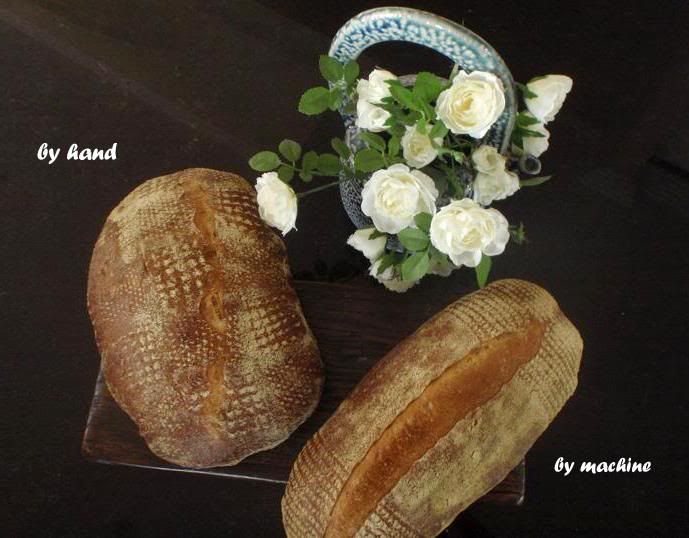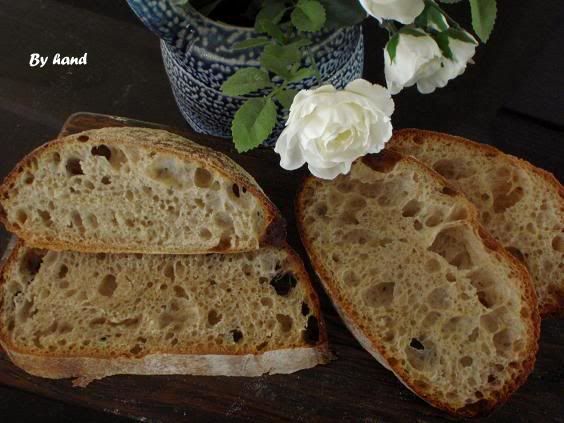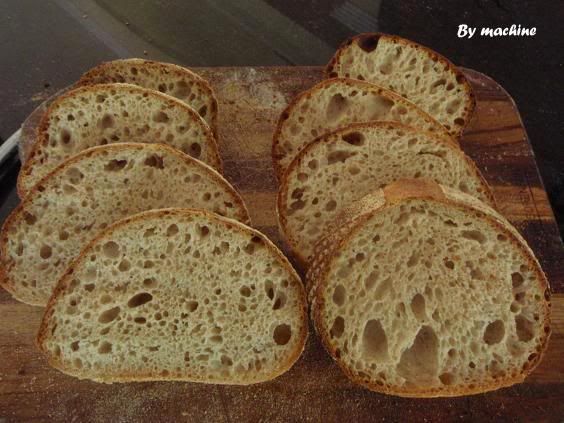I find Hamelman's Pain au Levain formula very attractive (page 158 of "[i]Bread[/i]"). A friend asked if I could do spelt sourdough for her. I thought I would try 20% spelt flour to start with. Essentially I took Hamelman's Pain au Levain with Whole-Wheat Flour formula (page 160 of "[i]Bread[/i]") and substituted spelt for whole-wheat flour. But I have no confidence in my bread machine to mix and knead the dough properly, so I made two versions to compare: one by hand, my way; and the other by machine, exactly as detailed in Hamelman's book.
[u][b][color=red]Formula[/color][/b][/u]
[b][u]First levain build[/u][/b] - 8 to 12 hours before final levain build
- 5 g starter
- 14 g bread flour
- 9 g water
[b][u]Final levain build[/u][/b] - 12 hours before final dough mixing
- 130 g bread flour
- 9 g stone-ground organic medium rye flour
- 85 g water
- 28 g mature culture from above (@ approx. 60% hydration)
Total levain 252 grams. Reserve 28 grams for future use; with the balance of 224 grams, I split it by two (ie, 112 grams each), one for the dough to be made by hand, and the other for the dough to be made by my bread machine.
[b][u]Final dough[/u][/b] - the quantity below is to be split by two as above
- 549 g bread flour
- 37 g stone-ground organic medium rye flour
- 181 g organic spelt flour (of which 1/2 is wholemeal spelt flour)
- 532 g water
- 17 g salt
- 224 g of levain from above
Total weight 1.54 kg to be split into two of 770 grams each; dough hydration 68%

Major differences in the two methods are as follows:
(1) Autolyse: With the hand mixing version, I autolyse [b]all[/b] ingredients, whereas with the other version, salt and levain are not mixed in until after the autolyse.
(2) The levain: In Hamelman's machine version, the levain is cut up in chunks and spread on top of the dough to mix. With my hand version, I diluted the levain thoroughly with the formula water before adding the flours in to mix. As a result, the levain in the hand version acts more vigorously. This means that fermentation happens faster in the hand version (see below).
(3) Fermentation: Temperature of both of the doughs was roughly 76F as recommended by Hamelman in his book. Bulk fermentation was 2 and a 1/2 hours and proofing was 2 hours. An interesting thing was that at the end of this fermentation time, I felt the two doughs with my finger - the one that was mixed and kneaded by bread machine felt just right, however, the hand version dough felt slightly [b]over-proofed[/b], very bubbly, gassy and fragile.
(4) Baking: I baked the hand version dough first (and placed the other into the refrigerator to wait for its turn).
(5) Scoring: My scoring for the hand version dough was shocking; the other one was easier for me as it was in the refrigerator for half an hour.


It is very obvious that that the hand version pain au levain has a more open crumb. Hamelman says of Pain au Levain with Whole-Wheat Flour that "the bread has a clean flavor and [b]a balanced acidity[/b]" this would apply to the two Pains au levain here with 20% Spelt as well. The flavour is really lovely.
It is very easy to over-ferment the dough. If dough temperature is higher or lower than the recommended 76F (24.5F) due to ambient temperature, fermentation time should be adjusted.
Shiao-Ping
- Shiao-Ping's Blog
- Log in or register to post comments
Another lovely looking bread. whether the hand-made version or the machine one.
I under-baked my last spelt loaf (although it had a higher percentage of spelt than this one of yours). It ended up heavy and doughy. I resorted to toasting it before deciding enough was enough and discarding the bit that was left. I'm looking forward to giving your version above a go.
Are you a late sleeper?
Just came back from dropping my son at his friend's place for the friend's mum to take them to Gold Coast for today's tennis match. As I was driving home I was musing why I found Hamelman's Pain le Levain formula attractive. I think the attractiveness lies in its simplicity. And in simplicity we want to make sure that the ingredients we use are of the best possible quality - not just about using suitable flours, but more importantly, the [b]levain[/b] has to be in good condition, not just alive, but healthy, vigorous, and very happy.
Another beautiful bake Shiao-Ping!
Are the patterns on the tops of your loaves from proofing on a towel or are they stencils?
tea towel and unexpected. There was one other time that I purposely tried to get the natural "pattern" but it came out bad.
Nice looking bread! Have you made this recipe with regular whole wheat rather than spelt in the past? If so, I'm curious what comparisons you can make, in terms of dough qualities, crumb, and flavor.
this was the second or third time ever that I used a Hamelman formula. It would be interesting to try just to compare as you indicated. I know his Pain le Levain with Whole-Wheat Flour formula is popular among TFL users.